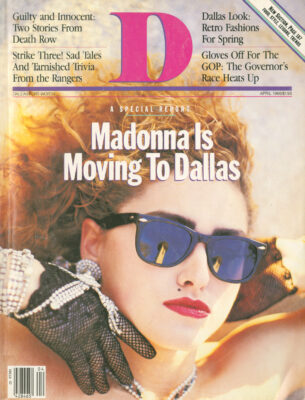WHEN THE GOING gets tough, the tough go to prime-time. Where better to spread the word, whether it’s for a new sexy after-shave lotion or Mary Tyler Moore speaking out about diabetes? The tube can do things no amount of print or other advertising can do. Now, mixed in among the glad tidings of laundry soap and fast cars, there’s a new slogan that’s being zapped across the country. And it’s message targeted to hit consumers in their pocketbooks-and national allegiance.
Bob Hope. Carol Channing. Don Johnson. They’re not kidding when they declare, “It matters to me,” as they display their “Made in USA” labels inside their clothes on national TV. It’s a patriotic cause that has them flapping their lapels for free. And the Crafted With Pride in the USA Council couldn’t be happier about it. The council is tapping the aid of patriotic Hollywood luminaries to catapult its $40 million “Buy American” blitz into nationwide consumer consciousness.
The advertising campaign is the direct result of economic bad times in the apparel industry resulting from escalating trade with foreign (often Third World) countries in which cheap labor abounds. Although im-ported products have always been an annoying presence to American industry, the overseas onslaught in recent years is virtually crippling the nation’s apparel industry, say Crafted With Pride proponents. And the situation has gone from bad to worse, they claim. Thus manufacturers, who used to enjoy healthy competition with each other have united to combat the foreign invasion.
Crafted With Pride executive Charlie Biddle claims that “since 1979, nearly 350.000 jobs have been lost in domestic textile mills, and more than 250 plants have closed.” To compound the problem, says Biddle, America’s import growth in the last couple of years has gone up “more than 19 percent a year.” And that’s only a conservative guess, he says, since tallies for 1983 and 1985 put the figures at 25 and 32 respectively.
Part of the runaway growth rates, says Biddle, can be attributed to cheaper labor costs in the Orient and developing countries. Low wages in the major import countries (averaging less than a dollar an hour wage as compared to America’s minimum wage of $3.35 an hour) have made it possible for retailers to buy many foreign goods (equal in quality to American products) at much lower prices, creating a devastating domino effect throughout the industry. By 1984, the entire apparel industry was in a financial slump, with a debt of $16.2 billion comprising a whopping 13 percent of the national trade deficit.
Manufacturers aren’t the only ones to recognize the problem. The federal government has passed a labeling law requiring all retail merchandise to have country-of-origin tags prominently displayed. But that wasn’t enough to turn things around. Roger Milliken of the Milliken Companies was one of the first to sound the alarm and call for cooperation among the industry’s constituents. Eventually, manufacturers and other apparel leaders banded together to form the CWP council in the spring of 1984. The organization has four major goals: to let consumers know [with the recently passed label law] that they have a choice between domestic or imported merchandise; to enhance the industry’s competitive standpoint by improving communications and capitalizing on U.S. resources (use high-tech systems at the retail level to keep factories informed of turnover rates); to gain support of “public opinion leaders” and the media; and finally, to convince retailers that stocking more U.S.-made goods will be financially advantageous.
According to Ann Pinkerton, the CWP account supervisor at Carl Byoir public relations firm, “the heartbeat of CWP is to make domestic manufacturers more competitive.” Key to that goal is Quick Response, a computer linkup between U.S. manufacturers and retailers. “There are too many uncertainties in dealing with the Far East,” she says. “If a retailer has a product that starts selling, he can’t reorder in time to capitalize on the high demand. The buyer has to travel to the Far East often, and the retailer has no power over quality control.”
And consumers, the strongest contingent in retail circles, are responding to the efforts of the CWP. Pinkerton says that “we’ve found consumers to be much more responsive than we had anticipated.” Pinkerton believes the “Buy American” campaign strikes a chord in today’s society: “It’s a thinking man’s patriotism, not a flag-waving thing.” As a result, she says, “the rate of import has slowed down this year.. .I think we’ll see nothing less than a turnaround.”
As for persuading American retailers to stock more U.S. goods, some department store executives are openly ambivalent. A PR spokesman for Neiman-Marcus says: “Our attitude toward domestic merchandise is as positive as it ever was.” He adds. “The store’s determination is not where the item is made, it’s ’Will our customers buy it?’ We look at the quality of the product, first.”
Related Articles

Local News
As the Suburbs Add More People, Dallas Watches Its Influence Over DART Wane
The city of Dallas appears destined to lose its majority of appointments on the DART board. How will that affect the delivery of public transit in the future?
By Matt Goodman

Home & Garden
A North Haven Gardens Coach is Helping You Reap What You Sow This Spring
Seasonal tips from North Haven Gardens' Kay Nelson.
By Jessica Otte

Arts & Entertainment
WaterTower Theatre Invites Audiences Backstage for an Evening with Louis Armstrong
Terry Teachout’s first play, SATCHMO AT THE WALDORF, shares details about Louis Armstrong after one of his final shows.
By Brett Grega


